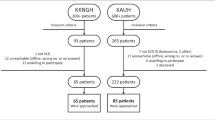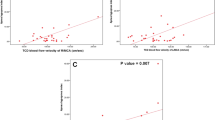Abstract
Purpose
Sickle cell disease (SCD) imparts an increased risk for obstructive sleep apnea (OSA) in childhood. Studies of pediatric SCD have identified an increased risk for pain and neurologic complications with comorbid OSA. We determined the rate of a broad range of SCD-related medical complications to better characterize the spectrum of SCD complications related to OSA.
Methods
Retrospective chart review at a single hematology clinic identified 641 youth with SCD who received consistent screenings for OSA as part of routine hematological health maintenance visits over an 11-year period. Medical complication rates in the 136 children with OSA determined by polysomnography exams were compared to 136 matched controls at lower risk for OSA due to negative OSA screenings or exams.
Results
Children with SCD and OSA had higher overall rates of SCD complications than low OSA-risk controls; lung morbidity showed the largest effect size. Infection, cardiovascular, and neurologic complications occurred at higher rates in children with OSA. Children with comorbid OSA had higher rates of SCD complications both before and after OSA diagnosis.
Conclusions
OSA in children with SCD is associated with higher rates of a broad range of SCD complications, including pneumonia and acute chest syndrome. Routine screenings, diagnosis, and increased therapeutic intervention for children with comorbid OSA could decrease SCD morbidity.


Similar content being viewed by others
References
Maddern BR, Reed HT, Ohene-Frempong K, Beckerman RC (1989) Obstructive sleep apnea syndrome in sickle cell disease. Ann Otol Rhinol Laryngol 98(3):174–178. https://doi.org/10.1177/000348948909800302
Robertson PL, Aldrich MS, Hanash SM, Goldstein GW (1988) Stroke associated with obstructive sleep apnea in a child with sickle cell anemia. Ann Neurol 23(6):614–616. https://doi.org/10.1002/ana.410230615
Brooks LJ, Koziol SM, Chiarucci KM, Berman BW (1996) Does sleep-disordered breathing contribute to the clinical severity of sickle cell anemia? J Pediatr Hematol Oncol 18(2):135–139. https://doi.org/10.1097/00043426-199605000-00007
Rosen CL, Debaun MR, Strunk RC, Redline S, Seicean S, Craven DI, Gavlak JCD, Wilkey O, Inusa B, Roberts I, Goodpaster RL, Malow B, Rodeghier M, Kirkham FJ (2014) Obstructive sleep apnea and sickle cell anemia. Pediatrics 134(2):273–281. https://doi.org/10.1542/peds.2013-4223
Rees DC, Williams TN, Gladwin MT (2010) Sickle-cell disease. Lancet 376(9757):2018–2031. https://doi.org/10.1016/S0140-6736(10)61029-X
Hassell KL (2010) Population estimates of sickle cell disease in the U.S. Am J Prev Med 38((4):S512–S521
Kato GJ, Gladwin MT, Steinberg MH (2007) Deconstructing sickle cell disease: reappraisal of the role of hemolysis in the development of clinical subphenotypes. Blood Rev 21(1):37–47. https://doi.org/10.1016/j.blre.2006.07.001
Gozal D, Kheirandish-Gozal L (2007) Neurocognitive and behavioral morbidity in children with sleep disorders. Curr Opin Pulm Med 13(6):505–509. https://doi.org/10.1097/MCP.0b013e3282ef6880
Marcus CL, Brooks LJ, Ward SD et al (2012) Diagnosis and management of childhood obstructive sleep apnea syndrome. Pediatrics 130(3):e714-e755
Abou-Elhamd KE (2012) Otorhinolaryngological manifestations of sickle cell disease. Int J Pediatr Otorhinolaryngol 76(1):1–4. https://doi.org/10.1016/j.ijporl.2011.10.004
Davies S, Stebbens VA, Samuels MP, Southall DP (1989) Upper airways obstruction and cerebrovascular accident in children with sickle cell anaemia. Lancet 334(8657):283–284. https://doi.org/10.1016/S0140-6736(89)90477-7
Kemp JS (1996) Obstructive sleep apnea and sickle cell disease. J Pediatr Hematol Oncol 18(2):104–105. https://doi.org/10.1097/00043426-199605000-00002
Kirkham FJ, Hewes DK, Prengler M, Wade A, Lane R, Evans JP (2001) Nocturnal hypoxaemia and central-nervous-system events in sickle-cell disease. Lancet 357(9269):1656–1659. https://doi.org/10.1016/S0140-6736(00)04821-2
Hargrave DR, Wade A, Evans JP, Hewes DK, Kirkham FJ (2003) Nocturnal oxygen saturation and painful sickle cell crises in children. Blood 101(3):846–848. https://doi.org/10.1182/blood-2002-05-1392
Adams RJ (2005) TCD in sickle cell disease: an important and useful test. Pediatr Radiol 35(3):229–234. https://doi.org/10.1007/s00247-005-1409-7
American Thoracic Society (1996) Standards and indications for cardiopulmonary sleep studies in children. Am J Respir Crit Care Med 153(2):866–878
Whitesell PL, Owoyemi O, Oneal P, Nouraie M, Klings ES, Rock A, Mellman TA, Berihun T, Lavella J, Taylor RE, Perrine SP (2016) Sleep-disordered breathing and nocturnal hypoxemia in young adults with sickle cell disease. Sleep Med 22:47–49. https://doi.org/10.1016/j.sleep.2016.05.006
Su VY, Liu CJ, Wang HK, Wu LA, Chang SC, Perng DW, Su WJ, Chen YM, Lin EY, Chen TJ, al CKT (2014) Sleep apnea and risk of pneumonia: a nationwide population-based study. CMAJ 186(6):415–421. https://doi.org/10.1503/cmaj.131547
Oga T, Chin K, Tabuchi A, Kawato M, Morimoto T, Takahashi K, Handa T, Takahashi K, Taniguchi R, Kondo H, Mishima M, Kita T, Horiuchi H (2008) Effects of obstructive sleep apnea with intermittent hypoxia on platelet aggregability. J Atheroscler Thromb 16(6):862–869
Yanni E Grosse SD, Yang QH, Olney RS (2009) Trends in pediatric sickle cell disease-related mortality in the United States, 1983-2002. J Peds. 154(4):541–545. https://doi.org/10.1016/j.jpeds.2008.09.052
Tauman R, Gozal D (2011) Obstructive sleep apnea syndrome in children. Expert Rev Respir Med 5(3):425–440. https://doi.org/10.1586/ers.11.7
Nur E, Biemond BJ, Otten HM, Brandjes DP, Schnog JJ, CURAMA Study Group (2011) Oxidative stress in sickle cell disease; pathophysiology and potential implications for disease management. Am J Hematol 86(6):484–489. https://doi.org/10.1002/ajh.22012
Muzumdar H, Raanan A (2013) Physiological effects of obstructive sleep apnea syndrome in childhood. Respir Physiol Neurobiol 188(3):370–382. https://doi.org/10.1016/j.resp.2013.05.006
Kheirandish-Gozal L, Gozal D, Pépin JL (2015) Inflammation in sleep debt and sleep disorders. Mediat Inflamm 2015:1–2. https://doi.org/10.1155/2015/343265
Grady AJ, Hankins JS, Haberman B, Schoumacher R, Stocks RM (2017) Hydroxyurea treatment effect on children with sickle cell disease and obstructive sleep apnea. Sleep Breath 21(3):697–701. https://doi.org/10.1007/s11325-017-1458-9
Narang I, Kadmon G, Lai D, Dhanju S, Kirby-Allen M, Odame I, Amin R, Lu Z, Al-Saleh S (2015) Higher nocturnal and awake oxygen saturations in children with sickle cell disease receiving hydroxyurea therapy. Annals of the American Thoracic Society 12(7):1044–1049. https://doi.org/10.1513/AnnalsATS.201410-473OC
Brietzke SE, Katz ES, Roberson DW (2004) Can history and physical examination reliably diagnose pediatric obstructive sleep apnea/hypopnea syndrome? A systematic review of the literature. Otolaryngol Head Neck Surg 131(6):827–832. https://doi.org/10.1016/j.otohns.2004.07.002
Hankins JS, Ware RE, Rogers ZR, Wynn LW, Lane PA, Scott JP, Wang WC (2005 Oct 1) Long-term hydroxyurea therapy for infants with sickle cell anemia: the HUSOFT extension study. Blood 106(7):2269–2275. https://doi.org/10.1182/blood-2004-12-4973
Scott JP, Hillery CA, Brown ER, Misiewicz V, Labotka RJ (1996) Hydroxyurea therapy in children severely affected with sickle cell disease. J Peds 128(6):820–828. https://doi.org/10.1016/S0022-3476(96)70335-9
Acknowledgments
This project was completed as part of doctoral degree requirements of the first author. No funding was received for this research.
Author information
Authors and Affiliations
Corresponding author
Ethics declarations
All procedures performed in studies involving human participants were in accordance with the ethical standards of the institutional and/or national research committee and with the 1964 Helsinki declaration and its later amendments or comparable ethical standards. For this type of study, formal consent is not required.
Conflict of interest
The authors declare that they have no conflict of interest.
Rights and permissions
About this article
Cite this article
Katz, T., Schatz, J. & Roberts, C.W. Comorbid obstructive sleep apnea and increased risk for sickle cell disease morbidity. Sleep Breath 22, 797–804 (2018). https://doi.org/10.1007/s11325-018-1630-x
Received:
Revised:
Accepted:
Published:
Issue Date:
DOI: https://doi.org/10.1007/s11325-018-1630-x




